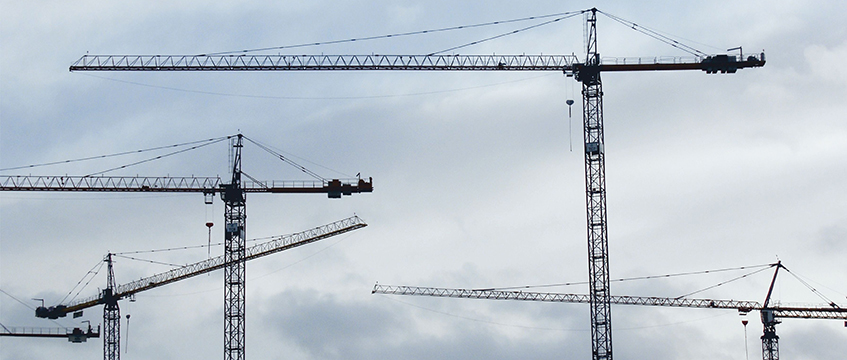London developers show greater risk appetite as office starts climb
Confidence in London’s office market is strengthening among developers as new starts jump by almost 12% and speculative appetite rises, according to Deloitte’s latest London Office Crane Survey.
The average scheme size has risen by 28% in the six months ending September, highlighting a greater appetite from developers to take on risk for individual schemes.
The number of new starts reached 3.4m sq ft in the six-month period, up from 3.1m sq ft in March and by nearly 32% year-on-year.
Confidence in London’s office market is strengthening among developers as new starts jump by almost 12% and speculative appetite rises, according to Deloitte’s latest London Office Crane Survey.
The average scheme size has risen by 28% in the six months ending September, highlighting a greater appetite from developers to take on risk for individual schemes.
The number of new starts reached 3.4m sq ft in the six-month period, up from 3.1m sq ft in March and by nearly 32% year-on-year.
Mike Cracknell, director in real estate at Deloitte, said the uptick underlined the wider resilience of offices as an asset class.
He noted “high levels” of speculative development above the report’s long-term average, reflecting developers’ ability to look beyond the short-term effects of the pandemic to “a future where occupancy and demand will rebound, even if working patterns and office configurations also change”.
Despite the rise in new starts, the total volume of offices under construction dropped by 4.9% to 13m sq ft. Deloitte said this was likely to have been driven by the recent completion of high volumes of development that were held up by pandemic-led disruption.
Some 3.6m sq ft of office development has been delivered, through 43 schemes. Although this lagged behind a record 4.5m sq ft coming to the market six months ago, Deloitte said the level stayed higher than the five-year average.
Cracknell said: “On the basis that we’re seeing an increased amount of refurbishment … and recognising that refurbishment schemes take less time and therefore sit in our survey for a shorter period, the amount of construction is really encouraging.”
Going greener
More than half (54%) of new starts were refurbishments. The remainder (46%) were new builds, rising from 33% in Q3 2020.
The report showed that the ongoing structural shift towards refurbishments has been driven by sustainability and concerns over embodied carbon.
A quarter of developers said they expect their new developments to be net zero by 2024, while 45% predicted they will achieve this between 2025 and 2029.
Philip Parnell, real estate valuation lead at Deloitte, said: “In addition to the cyclical attraction of refurbishments in uncertain times, concerns over embodied carbon have also prompted an aversion to outright demolitions.
“The focus on refurbishment over redevelopment is unlikely to diminish as carbon accounting including embodied carbon and the drive to net zero continues to gather momentum.”
More broadly, Cracknell said that cost-wise there is “a bit of a battle going on”, compounded by rising material prices for contractors. “Developers are having to respond in a very short time to make sure their buildings are climate change, ESG and Covid-friendly when at the same time, Covid and Brexit are having an impact on price,” he said.
“They are having to up the spec and it’s costing them more. But the numbers suggest they’re getting through that.”
Leasing optimism
The report also showed the vast majority of developers (90%) felt more optimistic about leasing demand than six months ago. Nearly two-thirds of developers expect their pipeline to increase and none expect it to fall, compared to just 7% and 29% respectively in winter 2020.
In central London, 31% of offices under construction are prelet, staying broadly flat compared with the previous six months.
Developers were found to be more sanguine about the impact of home-working on office demand than they were at the onset of the pandemic in 2020. More than a third (37%) now expect home working to have no impact on leasing demand, three times the proportion (12%) compared to a year ago.
Siobhan Godley, real estate leader at Deloitte, said: “It’s clear that the focus for the future is on high-quality sustainable office space. Occupiers’ requirements are also changing as flexibility becomes a key priority to accommodate varying work patterns and the market is responding with a wider choice of leasing arrangements for offices.
“Amenities continue to be shaped by the impact of the pandemic, increasingly centring on promoting health and wellbeing; from improved ventilation and mindful spaces to removing unnecessary touchpoints such as lift buttons.”
The legal sector accounted for 17% of prelets during the period, against a five-year average of 9%.
Although the technology, media and telecom sector continued to dominate the total amount of prelets, it eased to a 28% share of the market, from 40% in the period to March.
The City and the West End were the biggest hotspots for new projects. However, new starts in Midtown were at their lowest level since Q3 2019. There was no new construction activity at Southbank or Paddington.
In contrast, there was an upturn in the volume of new projects at King’s Cross and Docklands.
To send feedback, e-mail pui-guan.man@eg.co.uk or tweet @PuiGuanM or @EGPropertyNews
Image: Geoff Robinson Photography/REX/Shutterstock











